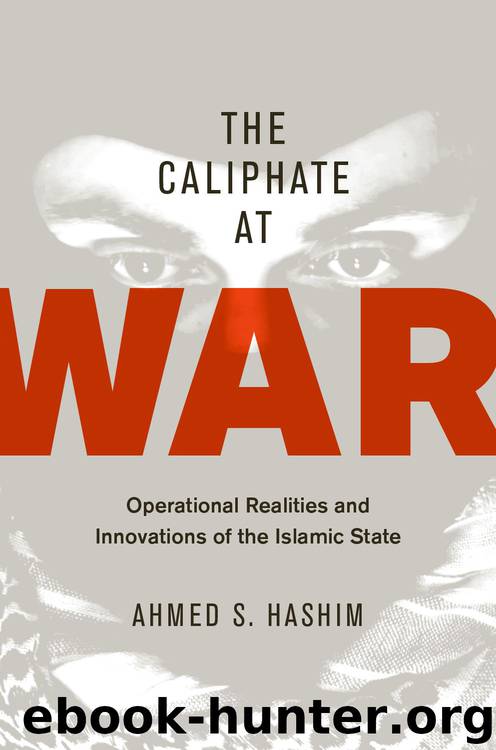The Caliphate at War by Ahmed S. Hashim

Author:Ahmed S. Hashim
Language: eng
Format: epub
ISBN: 9780190668501
Publisher: Oxford University Press
Published: 2017-10-27T16:00:00+00:00
Suicide Bombing Tactics
Zarqawi’s organization relied heavily on suicide bombings, beginning with individual suicide bombers whose logistical requirements were not too onerous. To put it briefly, the requirements were an individual willing to die in the commission of his attack, a suicide vest with explosives, a safe house, and a small cell of minders who prepared the individual for the mission. As Zarqawi’s organization grew, it acquired more resources and personnel; this allowed it to develop the more deadly SVBIED.14
Eventually, the jihadists managed to manufacture and use the more deadly SVBIED, which a specially designated individual, willing to be vaporized in the process, drove to or into the target. The Zarqawi network targeted a wide variety of groups, including the Iraqi Security Forces, political and religious figures, civilians, foreign civilian contractors, and United Nations and humanitarian workers. Between 2003 and 2010, according to the prestigious British medical journal the Lancet, suicide bombings killed twelve thousand civilians but “only” two hundred soldiers in the U.S.-led Coalition, the vast majority of them (175) U.S. military personnel.
Zarqawi justified suicide bombing as the most effective operational method for the jihadists: “The brothers’ most effective weapon, after relying on God and praying to Him for success, has been martyrdom operations. It is the brothers’ unanswerable weapon for which the enemy can find no remedy. The enemies cannot prevent such operations. As we said, the enemies are present among the population and place their bases among the people’s houses. They do so cunningly to place barriers between them and the mujahidin. Hence these martyrdom operations have played a big role in weakening the enemy and making it reach this level of despair, confusion, defeatist spirit, and psychological collapse.”15 Kurdish radical Mullah Krekar of Ansar al-Islam, an ally of Zarqawi, reportedly stated: “martyrdom operations … are effective because our losses are little and the opposition’s losses are great.”16
Zarqawi and his immediate successors were never able to produce SVBIEDs (or for that matter VBIEDs) on the industrial scale that ISIS and then IS were able to do much later on. However, it was the suicide bombing operations that ultimately allowed Zarqawi and his organization to frustrate the American effort to stabilize post-Baathist Iraq and to ignite the civil war between the Sunni and Shia communities in Iraq. His organization made its presence known as early as August 2003, when they began their “offensive” campaign. They first bombed the Jordanian embassy in Baghdad. The truck bombing of the United Nations headquarters in Baghdad, which killed twenty-three personnel, including the United Nations special representative for Iraq, followed on the heels of the embassy attack.
Zarqawi also initiated offensive attacks in August 2003 against the Shias, when he targeted the Imam Ali Mosque in Najaf, killing seventy-five worshipers and the leader of the Supreme Council for the Islamic Revolution of Iraq, Ayatollah Mohammad Baqr al-Hakim. Zarqawi’s attacks ranged from single suicide bombers to large-scale complex attacks spanning multiple cities. He followed attacks with Internet-based media campaigns explaining the intent behind the attacks and encouraging jihadists to join AQI in the fight against the U.
Download
This site does not store any files on its server. We only index and link to content provided by other sites. Please contact the content providers to delete copyright contents if any and email us, we'll remove relevant links or contents immediately.
| Arms Control | Diplomacy |
| Security | Trades & Tariffs |
| Treaties | African |
| Asian | Australian & Oceanian |
| Canadian | Caribbean & Latin American |
| European | Middle Eastern |
| Russian & Former Soviet Union |
The Secret History by Donna Tartt(18849)
The Social Justice Warrior Handbook by Lisa De Pasquale(12142)
Thirteen Reasons Why by Jay Asher(8796)
This Is How You Lose Her by Junot Diaz(6794)
Weapons of Math Destruction by Cathy O'Neil(6146)
Zero to One by Peter Thiel(5686)
Beartown by Fredrik Backman(5599)
The Myth of the Strong Leader by Archie Brown(5425)
The Fire Next Time by James Baldwin(5249)
How Democracies Die by Steven Levitsky & Daniel Ziblatt(5128)
Promise Me, Dad by Joe Biden(5087)
Stone's Rules by Roger Stone(5026)
A Higher Loyalty: Truth, Lies, and Leadership by James Comey(4845)
100 Deadly Skills by Clint Emerson(4840)
Rise and Kill First by Ronen Bergman(4704)
Secrecy World by Jake Bernstein(4646)
The David Icke Guide to the Global Conspiracy (and how to end it) by David Icke(4625)
The Farm by Tom Rob Smith(4438)
The Doomsday Machine by Daniel Ellsberg(4416)
